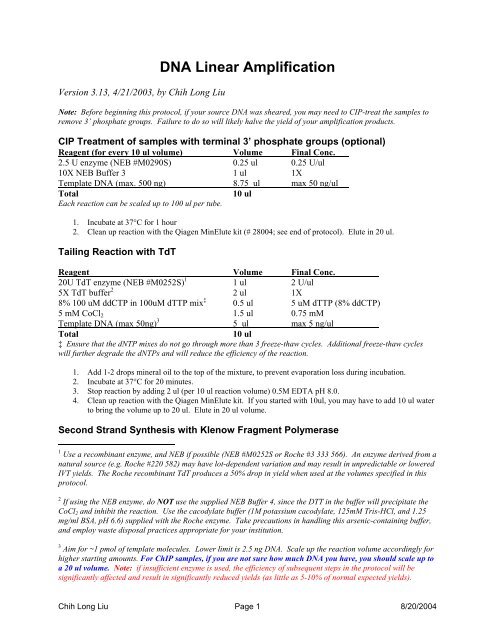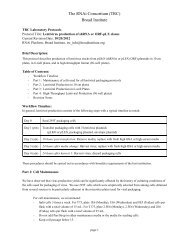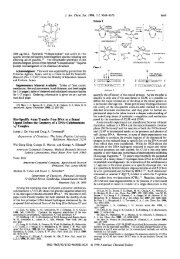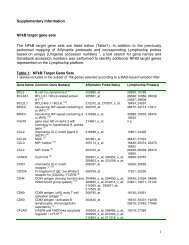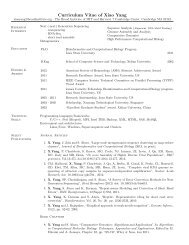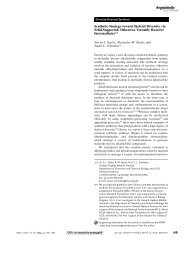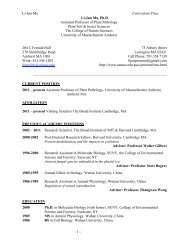DNA Linear Amplification - Broad Institute
DNA Linear Amplification - Broad Institute
DNA Linear Amplification - Broad Institute
You also want an ePaper? Increase the reach of your titles
YUMPU automatically turns print PDFs into web optimized ePapers that Google loves.
Version 3.13, 4/21/2003, by Chih Long Liu<br />
<strong>DNA</strong> <strong>Linear</strong> <strong>Amplification</strong><br />
Note: Before beginning this protocol, if your source <strong>DNA</strong> was sheared, you may need to CIP-treat the samples to<br />
remove 3’ phosphate groups. Failure to do so will likely halve the yield of your amplification products.<br />
CIP Treatment of samples with terminal 3’ phosphate groups (optional)<br />
Reagent (for every 10 ul volume) Volume Final Conc.<br />
2.5 U enzyme (NEB #M0290S) 0.25 ul 0.25 U/ul<br />
10X NEB Buffer 3 1 ul 1X<br />
Template <strong>DNA</strong> (max. 500 ng) 8.75 ul max 50 ng/ul<br />
Total 10 ul<br />
Each reaction can be scaled up to 100 ul per tube.<br />
1. Incubate at 37°C for 1 hour<br />
2. Clean up reaction with the Qiagen MinElute kit (# 28004; see end of protocol). Elute in 20 ul.<br />
Tailing Reaction with TdT<br />
Reagent Volume Final Conc.<br />
20U TdT enzyme (NEB #M0252S) 1 1 ul 2 U/ul<br />
5X TdT buffer 2 2 ul 1X<br />
8% 100 uM ddCTP in 100uM dTTP mix ‡ 0.5 ul 5 uM dTTP (8% ddCTP)<br />
5 mM CoCl2 1.5 ul 0.75 mM<br />
Template <strong>DNA</strong> (max 50ng) 3 5 ul max 5 ng/ul<br />
Total 10 ul<br />
‡ Ensure that the dNTP mixes do not go through more than 3 freeze-thaw cycles. Additional freeze-thaw cycles<br />
will further degrade the dNTPs and will reduce the efficiency of the reaction.<br />
1. Add 1-2 drops mineral oil to the top of the mixture, to prevent evaporation loss during incubation.<br />
2. Incubate at 37°C for 20 minutes.<br />
3. Stop reaction by adding 2 ul (per 10 ul reaction volume) 0.5M EDTA pH 8.0.<br />
4. Clean up reaction with the Qiagen MinElute kit. If you started with 10ul, you may have to add 10 ul water<br />
to bring the volume up to 20 ul. Elute in 20 ul volume.<br />
Second Strand Synthesis with Klenow Fragment Polymerase<br />
1 Use a recombinant enzyme, and NEB if possible (NEB #M0252S or Roche #3 333 566). An enzyme derived from a<br />
natural source (e.g. Roche #220 582) may have lot-dependent variation and may result in unpredictable or lowered<br />
IVT yields. The Roche recombinant TdT produces a 50% drop in yield when used at the volumes specified in this<br />
protocol.<br />
2 If using the NEB enzyme, do NOT use the supplied NEB Buffer 4, since the DTT in the buffer will precipitate the<br />
CoCl2 and inhibit the reaction. Use the cacodylate buffer (1M potassium cacodylate, 125mM Tris-HCl, and 1.25<br />
mg/ml BSA, pH 6.6) supplied with the Roche enzyme. Take precautions in handling this arsenic-containing buffer,<br />
and employ waste disposal practices appropriate for your institution.<br />
3 Aim for ~1 pmol of template molecules. Lower limit is 2.5 ng <strong>DNA</strong>. Scale up the reaction volume accordingly for<br />
higher starting amounts. For ChIP samples, if you are not sure how much <strong>DNA</strong> you have, you should scale up to<br />
a 20 ul volume. Note: if insufficient enzyme is used, the efficiency of subsequent steps in the protocol will be<br />
significantly affected and result in significantly reduced yields (as little as 5-10% of normal expected yields).<br />
Chih Long Liu Page 1 8/20/2004
Reagent* Volume Final Conc.<br />
25 uM T7-A18B primer 4 0.6 ul 300 nM<br />
10X EcoPol buffer || 5 ul 1X<br />
5.0 mM dNTP mix ‡ 2 ul 200 uM<br />
water 20.4 ul<br />
T-Tailed <strong>DNA</strong> 20 ul<br />
Total 48 ul<br />
* If production of template-independent product is a significant problem, scale down the reaction volume, while<br />
keeping the reagent concentrations (except for the T-Tailed <strong>DNA</strong>) constant.<br />
‡ Ensure that the dNTP mixes do not go through more than 3 freeze-thaw cycles. Additional freeze-thaw cycles<br />
will degrade the dNTPs and will reduce the efficiency of the reaction.<br />
|| Ensure any DTT in the buffer has completely dissolved before using. Pre-warm to 37°C if necessary.<br />
Do NOT use mineral oil. Trace amounts of mineral oil appears to interfere with cleanup and IVT.<br />
Use the following program in a thermal cycler:<br />
94°C, 2 minutes to melt ramp -1°C/sec to 35°C, then hold for 2 minutes to anneal ramp –0.5°C/sec to 25°C <br />
hold for 45 seconds (pause here if needed) and add 2 ul (50U) Klenow <strong>DNA</strong> polymerase (NEB# M0210S) during<br />
this time 37°C, 90 minutes to extend.<br />
Stop reaction by adding 5 ul 0.5M EDTA, pH 8.0 (end conc. 50 mM).<br />
Second Strand <strong>DNA</strong> Cleanup<br />
Clean up reaction with the Qiagen MinElute kit and elute in 20 ul.<br />
In Vitro Transcription (IVT)<br />
(uses the Ambion T7 Megascript Kit #1334)<br />
ds<strong>DNA</strong> preparation<br />
The IVT requires that the ds<strong>DNA</strong> be in 8 ul volume. Dry down the eluate from 20 to 8 ul in a speedvac at<br />
medium heat for 10-12 minutes.<br />
Reagent Volume<br />
75 mM NTP Mix (A, G, C, & UTP)* 8 ul<br />
Reaction buffer (warm to RT first!)** 2 ul<br />
Enzyme mix (RNase inhibitor and T7 RNA Pol) 2 ul<br />
Template ds<strong>DNA</strong> 8 ul<br />
Total 20 ul<br />
* If new kit, combine NTPs into one tube, then aliquot back out into the 4 tubes. In the first three freeze-thaw<br />
cycles, yields drop approximately 10-15% after each cycle. If the NTPs go through more than 3 freeze-thaw cycles,<br />
each subsequent freeze-thaw cycle may drop the yield by as much as 50%.<br />
** If you add cold buffer and ds<strong>DNA</strong>, you may risk precipitation of your <strong>DNA</strong>.<br />
Incubate at 37°C O/N (acceptable range is 5-20 hours). Incubate in thermal cycler with heated lid, or in air<br />
incubator, and in 0.2 ml RNase-free PCR tubes to minimize vapor volume.<br />
4 T7-A18B primer: (5’- GCATTAGCGGCCGCGAAATTAATACGACTCACTATAGGGAG(A)18[B], where B<br />
refers to C, G or T). This should be obtained with HPLC, PAGE, or equivalent purification.<br />
Chih Long Liu Page 2 8/20/2004
aRNA Purification Using Qiagen RNeasy Columns<br />
Use the Qiagen RNeasy Mini kit (#74104) for this procedure. You may eventually have to order additional Buffer<br />
RPE if you use the entire kit for this purpose.<br />
Make up RLT w/ β-ME and H2O Master Mix:<br />
Reagent Volume<br />
β-ME (14.2M stock solution) 3.5 ul<br />
RNase-free water 80 ul<br />
Buffer RLT (from Qiagen RNeasy Mini kit) 350 ul<br />
Total 433.5 ul<br />
1. Pre-aliquot the mix to 1.5 ml RNase-free tubes.<br />
2. Transfer contents of the IVT mix to the RNase/DNase-free tube and vortex briefly.<br />
3. Add 250ul ethanol (95-100%) and mix well by pipetting. (Do not spin here!)<br />
If you have a Qiagen vacuum manifold, skip to step 8.<br />
No Vacuum Manifold:<br />
4. Apply sample (700ul) to RNeasy mini spin column sitting in a collection tube. Centrifuge 15 sec at ≥<br />
8000 × g. Discard flow through.<br />
5. Transfer RNeasy column to a new 2-ml collection tube (supplied). Add 500ul Buffer RPE (which<br />
must contain ethanol) and centrifuge 15 sec at ≥ 8000 × g. Discard flow-through but re-use tube.<br />
6. Pipet 500ul Buffer RPE onto RNeasy column and centrifuge for 2 min at maximum speed.<br />
7. Remove flow through and pipet another 500ul Buffer RPE onto column. Centrifuge for 2 min at<br />
maximum speed. [This is an additional wash that is not in the Qiagen protocol which we have found<br />
necessary because of GITC contamination in the eluted RNA.] Skip to Step 12.<br />
Vacuum Manifold:<br />
8. Apply sample (700ul) to RNeasy mini spin column, attached to vacuum manifold. Apply vacuum.<br />
9. Remove vacuum and pipet 500ul Buffer RPE onto RNeasy column. Apply vacuum.<br />
10. Repeat Step 9, and transfer columns to 2-ml collection tubes (supplied). Spin 1 min at full speed.<br />
11. Return columns to vacuum manifold and apply 500ul Buffer RPE. Apply vacuum.<br />
12. (Transfer columns back to the 2-ml tubes;) Spin at full speed for 1 min to completely dry column.<br />
13. Transfer RNeasy column into a new 1.5-ml collection tube (supplied) and add 30ul RNase-free water<br />
directly onto membrane. Centrifuge for 1 min at ≥ 8000 × g to elute. Repeat if expected yield is ≥ 30<br />
ug.<br />
14. Check RNA concentration and quality by measuring A260 and A260/A280.<br />
15. Synthesize/label probe with random primer in RT reaction; hyb to arrays<br />
Qiagen MinElute Kit protocol<br />
The MinElute kit removes free nucleotides and anything below 40nt. Things between 40-70nt might also be<br />
removed but at a lower efficiency.<br />
1. In a sample of volume 20-100 ul, add 300 ul Buffer ERC and mix thoroughly. If the sample is in less than<br />
20 ul, bring up volume with ddH2O. If the sample is in more than 100 ul, split sample and do in parallel.<br />
2. Add sodium acetate (pH 5.0) if the buffer color is orange or purple (i.e. pH > 7.5). If the buffer is yellow,<br />
no additional sodium acetate is necessary.<br />
3. Apply sample to column. Spin 1 min. at maximum speed in microcentrifuge.<br />
Chih Long Liu Page 3 8/20/2004
4. Discard flow-through and add 750 ul Buffer PE (which must contain ethanol). Spin 1 min. at maximum<br />
speed in microcentrifuge.<br />
5. Discard flow-through. Spin 1 min. at maximum speed in microcentrifuge to dry column.<br />
6. Transfer columns to fresh 1.5 ml tubes. Pipette 10-20ul Buffer EB or water directly onto column<br />
membranes. Let stand for 1 minute, then spin 1 min. at maximum speed in microcentrifuge to elute.<br />
7. Note on elution volumes: when working with amounts less than 100ng of <strong>DNA</strong>, the 10ul elution volume<br />
in Qiagen’s MinElute protocol may recover less than the 80% claimed by Qiagen. Increase elution volume<br />
to 15-20 ul, and dry the volume down if necessary. At the post-SSS step, an elution volume of 20ul<br />
increased yields by 30-40% for a 50ng sample!<br />
Time per protocol step<br />
Step Time<br />
TdT Tailing and Cleanup: 30-40 minutes<br />
Second Strand Synthesis and Cleanup: 2-2.5 hours<br />
IVT: 5.5-20.5 hours<br />
IVT Cleanup: 15-30 minutes<br />
Gel (QC) and Spec (quantitation): 40-60 minutes<br />
Total: 9.5-25 hours<br />
Chih Long Liu Page 4 8/20/2004


